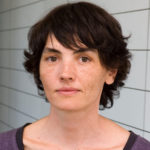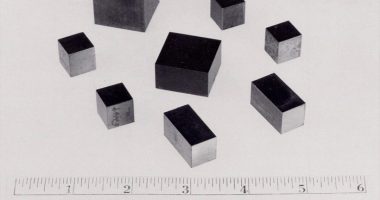
A CSIRO scientist examining no-fines light-weight aggregate concrete at the CSIRO Division of Building Research, Melbourne | CSIRO | CC BY 3.0
The question why turns us from processors of facts into seekers of causes that explain the world. But can we conceive an event without a cause, one that is purely random? The Bell Test shows that the result of measurement on a quantum particle emerges at the moment of the measurement, in other words, that before the measurement, the reality is not defined. Thus, with regard to quantum physics, the chain of whys has a random origin and in order to guide us through this uncertainty, we need a new sense.
Autumn. With the fourth season of the year comes this, the fourth part of “The Quantum Sense”. Last winter, as we welcomed in the New Year, we proposed to sharpen up our sense of humour in the quest for a new sense and to prepare ourselves for understanding quantum physics as one prepares to read a book by Chesterton: knowing that a rich and disconcerting order is going to emerge from the void to remain for ever. In spring, with the vigour of new sap and blood, we ventured out to twist the sense into vicious circles and paradoxes. With the maturity of the summer, having recovered sympathy for the clear and the manageable, we invited a reconsideration of quantum phenomena in terms of the concept of information, significantly clarifying the sense. With autumn, the time has come for gathering, reflection and descent into the depths.
If we imagine words as pools of underground water, with their fresh springs from which we drink and groundwater flows that communicate them, at different depths of the “sense” pool there are fish swimming – some old, heavy and slow, others smaller, faster and more nimble – and they also move around other pools: “perception”, “observer”, reality”, “norm”, “direction”, “flow”, “why”. Of all these, I think that it can be said that the most fundamental, the one with the calmest, deepest waters, is the “why” pool.
“Why”, the relationship between cause and effect, seemingly (although everything is debatable) has been entrenched in our mental processes since very ancient times.
One can ask which capability of our brains is responsible for us being able to think in causal terms. Historian Yuval Harari says (although everything is debatable) that it is our capacity to imagine, to visualise in our mind what is not before our eyes. We can convert a fact into an effect because we can mentally situate it close to another fact and relate them via a causal connection.
One can also ask oneself if we necessarily have to understand the world in causal terms. The computation scientist Judea Pearl has devoted a large part of his career and his books, especially the latest one: “The Book of Why. The New Science of Cause and Effect”, to defending the role of causality (A is the cause of B) as a key element in the mission of understanding or explaining, especially in reference to the context of his work in artificial intelligence.
Pearl’s book starts off with an anecdote, which is between analytical and poetical, in which he explains that as an adult, in one of his re-readings of the book of Genesis, he was struck by a detail that until that point had passed him by unnoticed: God, on discovering that Adam and Eve had eaten of the forbidden fruit, asked each of them separately what they had done and they both answered that they had eaten of the forbidden fruit because Eve and the snake, respectively, had offered it to them. In other words, God asked “what” and they answered “why”. Pearl converts this detail into pure gold. It serves him first to identify it as a differentiation between facts and reasons. Stories, explanations, accounts, are formed by reasons, not facts. In other words, there is a difference between the way of understanding the world as mere processors of facts (establishing correlations) and as seekers of causes. And here is where the poetry comes in: there is a need for a new fruit, a push, an outside intervention, to move from facts to reasons. It is what Pearl calls the ladder of causation. This is what turns us from processors of facts into seekers of causes, explainers of the world. I imagine that this point is also arguable, but it is undeniable that the idea is as attractive as it is inspiring.
This facet of ours as seekers of causes does not convert us into identifiers of a single cause, of a chain of events, it is a case of being capable of extracting ever more complex information to be able to increasingly fine-tune the relative composition of the set of things that favour the appearance of a certain event. It is not a case, therefore, of making conclusions about the true functioning of the world. In the majority of cases it is impossible in experimental terms to take on proving or ruling out with absolute rigour that a certain event A is the cause of another event B.
Can we, the sapiens, who boast the capacity to imagine and employ it to extract invisible relationships from the environment that we have used to turn ourselves into the species with the most advanced science and technology, also conceive an event that has no cause, a purely random event? We could answer that yes, in fact among all the things imaginable, we have created games of chance. But when we analyse it carefully, the chance in these games is not based on the absence of causes, but on the absence of control over all the conditions that determine a specific one out of many possibilities occurring.
The statement “an event exists that has no cause” also seems to be impossible to demonstrate experimentally. It can always be argued that the cause does exist, but has not been identified yet. However, an experiment does exist that shows that certain types of phenomena are purely random. This is the Bell Test experiment, and the types of phenomena that it describes are the measurements of the properties of quantum particles.
Physicist John Bell designed this experiment in 1964 to settle an argument that appeared to be interminable: that between those in favour of Bohr’s interpretation of quantum physics, who advocated that chance was at the heart of the fundamental processes of nature, and those in favour of Einstein’s “God does not play dice”, who proposed the search for theories based on certain hidden variables as responsible for this apparently random behaviour.
But the search for hidden variables could last forever! The philosophical dispute about chance could have no end! The failure to find hidden variables could be simply due to the very fact that they were hidden. How can it be demonstrated that something does not exist? Logically, it is impossible!
The highly ingenious method proposed by Bell enables the designing of experiments that show that the results of the measurements of a quantum particle emerge right at the moment of the measurement. It shows that it is not possible that it was determined before the experiment started, by any set of values for the set of supposed hidden variables. In other words, it shows that the results of the measurement are purely random.
In addition to settling the Einstein-Bohr argument and helping to clarify the nature of quantum mechanics, the Bell Test is the basis of a new class of quantum technologies, in particular of quantum cryptography, the security of whose protocols is based on the randomness certified by this experiment.
If there is no “why”, if we accept that the results of the measurement are random, we have to accept that before measuring, before the action of the observer, the reality is not defined. Which means that beyond physics and technology, the Bell Test has wide-reaching philosophical implications regarding what we understand as reality and the relationship between observer and reality.
Since an experiment exists that shows that the “why” fish have difficulties in accessing the “quantum” pool and yet they swim around the “sense” pool, the Bell Test is also the definitive demonstration that to understand quantum physics a new “sense” is needed.






Jesús | 04 September 2019
Siempre llaman mi atención los artículos de física teórica en los que se intentan sacar conclusiones. Es muy interesante que la realidad no sea local y esas cosas. Hace falta otro “sentido”, y me alegro de que lo diga una licenciada en física, pero eso no debería ser el final sino el principio. Si tuvieras que arriesgarte a decir por dónde comienza ese nuevo sentido, ¿por dónde lo enfocarías?
Yo lo enfocaría como una realidad puramente de ondas cuyo medio de propagación es el vacío. El problema es que nadie ha desarrollado nunca una teoría de fluidos continuos porque todos los que se conocen están hechos de partículas. Imagino que las propiedades de la materia como la masa, la inercia, el momento lineal y angular, energía y demás, han sido heredadas del vacío, pero no sé cuáles deberían ser exactamente los principios físicos que deberían aplicarse cuando interaccionan ondas de vacío entre sí. ¿Se conservaría la cantidad de movimiento, reaccionarían en proporción a la densidad…?
En fin, sería mucha suerte si estuvieras interesada en desarrollar una teoría de fluidos continuos, a lo mejor tengo razón y esa debería ser la base de toda la física. ¿?
Leave a comment